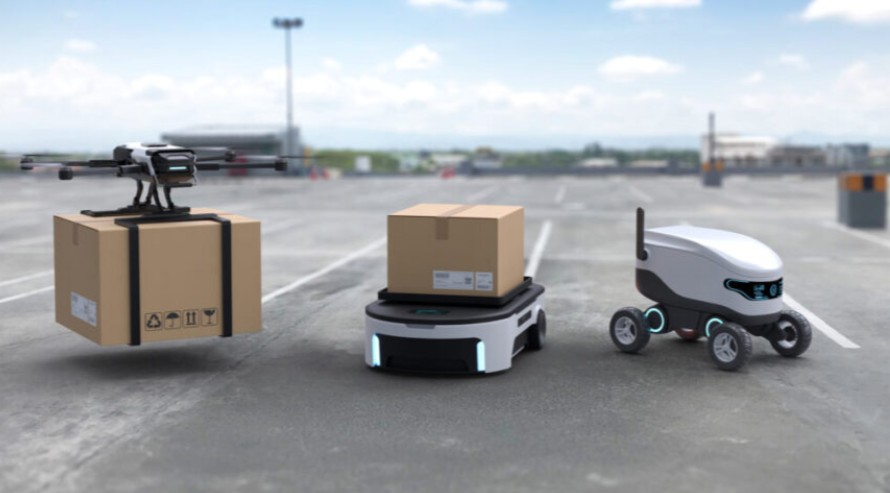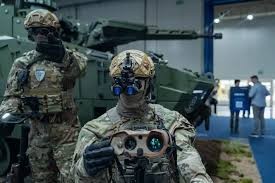Autonomous Delivery: Revolutionizing the Future of Logistics
Fast and effective delivery services are in high demand in this day and age, when customers can have everything, they want with just a few clicks. Autonomous delivery is a futuristic technology that logistics and tech companies worldwide are adopting to stay competitive. Autonomous delivery systems have transcended science fiction, from autonomous trucks and sidewalk robots to drones flying through the skies. They will soon be at our doorsteps, but they are currently in our streets and sky. The autonomous last-mile delivery technologies depicted in Figure 1 represent the supply chain of the future.

Figure 1: Autonomous Systems for Last-Mile Delivery: The Future of Logistics.
Autonomous Delivery
The term "autonomous delivery" describes the deployment of robots, drones, or self-operating automobiles to deliver goods without the need for human operators or drivers. These autonomous machines, which are driven by Artificial Intelligence (AI), GPS, and sophisticated sensors, move through their surroundings to transport things effectively and securely. A Transforma Insights analysis projects that by 2032, there will be 4.7 million autonomous robots for delivery operating worldwide [1].
Usually small, wheeled devices, delivery robots that are autonomous can transport food, groceries, or deliveries straight to customers. These robots are already being used in a number of metropolitan environments across the world by businesses like Starship Technologies and Nuro. Robots like these wait courteously at crosswalks, ignore pedestrians, and move down sidewalks. Numerous advanced transportation technologies that are revolutionizing logistics are part of autonomous delivery.
Autonomous Transportation Examples
- Self-Driving Freight Trucks
- Aerial Drones
- Last-Mile Robots
- Warehouse Robots
Firms such as Tesla, Aurora, and Uber Freight are making significant investments in autonomous freight vehicles in response to the worldwide truck driver crisis, particularly in the U.S. and Europe. On long-distance routes, these vehicles are expected to improve the speed of delivery and save wages.
Businesses including Wing (Alphabet), Walmart, and Amazon are testing drones for delivery. With delivery durations as short as 15 minutes, these flying devices are especially helpful in rural and crowded urban regions.
The final segment of the shipping journey, from the local center to your doorstep, is where these tiny, ground-based robots are intended to be used. They improve the sustainability and economics of deliveries by resolving the "last-mile problem."
Robots at warehouses are scheduling, retrieving, and moving shipments under the scenes to streamline operations. Proteus, Amazon's first completely autonomous mobile robot, is one of eight robots the company has created to help with the operation of warehouses.
Leading Companies in the Domain
- Amazon
Although Amazon Robotics has transformed warehouse automation, the company's sidewalk delivery initiative, which included the robot Scout, was abandoned in 2022 due to unsatisfactory consumer feedback. Prime Air, its drone delivery program, is still growing, though.
- Uber
Currently, Uber Eats uses self-driving delivery robots in eleven different locations, including Dallas and Tokyo. Thanks to collaborations with companies like Cartken, Nuro, and Serve Robotics, users can now use the app to gain access to their delivery box, get updates, and monitor their robot shipment in real time.
- Inceptio Technology
ZTO Express received 400 autonomous freight vehicles from China's Inceptio Technology in 2024, the biggest shipment to date. In the meantime, Uber's tech collaborator Aurora is preparing to introduce driverless trucks in 2025 across Dallas and Houston.
Autonomous Drones Are Taking Off
Drones are quickly evolving into a multipurpose tool for use in industrial, medical, and defense settings in addition to retail.
- Retail & Food Delivery
Drone fleets are being tested by companies including Wing, Amazon, and Walmart in an effort to transport small things to homes quickly.
- Industrial & Healthcare Use
Drones have been used to: - Deliver healthcare supplies from one hospital to another, deliver spare components within factories, oversee distribution centers' inventories, provide supplies to facilities and ships that are offshore.
- Military Applications
These days, autonomous drones play a vital role in military logistics by lowering human risk when transporting supplies, food, and medication to soldiers in hazardous or isolated areas.
Challenges on the Road Ahead
- High initial expenditures for facilities, infrastructure and equipment
- Complicated laws, particularly those pertaining to public safety and the utilization of drones
- Practical restrictions on navigation and climate control
Addressing Autonomous Delivery's Obstacles
Even with the potential, there are still a number of obstacles. Implementation may be delayed by strict rules and inadequate infrastructure. Building specialized sidewalks, charging stations, and local data centers to facilitate computational power and low-latency connectivity are some solutions. It is also crucial to have a strong drone air traffic control system [2]. Furthermore, demand is being increased by the fast urbanization. The need for urban delivery will increase significantly as the world's population is expected to reach 8.5 billion people by 2030, with 60% of them residing in cities. Delivery and transportation for passengers will increase traffic in cities, which currently account for 70% of carbon emissions. By lowering emissions, cutting delivery costs, and promoting environmental objectives, autonomous delivery presents a possible answer to these problems.
The movement of commodities from point of origin to point of destination is being revolutionized by autonomous delivery, which is not merely a passing trend. You should anticipate seeing smart, self-driving systems for delivery on sidewalks, streets, even in the sky as businesses push the envelope and consumers become more accustomed to automation.
References
- https://vivatechnology.com/news/autonomous-delivery-robots-delivering-the-future-of-logistics
- https://www.parcelandpostaltechnologyinternational.com/features/the-growth-and-opportunities-of-autonomous-last-mile-delivery-in-the-e-commerce-industry.html
Cite this article:
Archana Sasi (2025), Autonomous Delivery: Revolutionizing the Future of Logistics, AnaTechMaz, pp.695.





